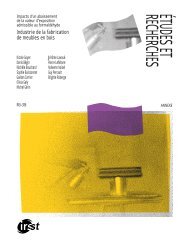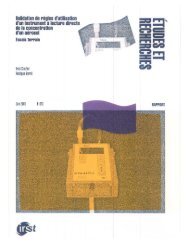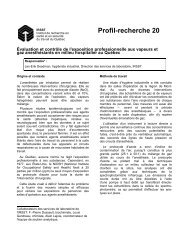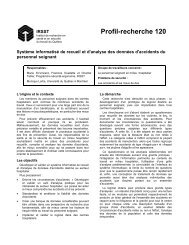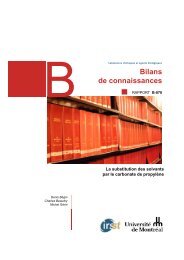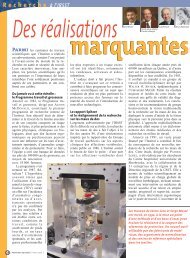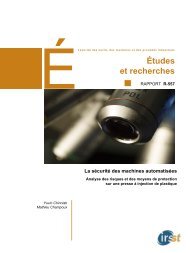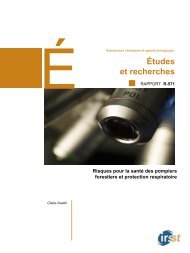Sampling Guide for Air Contaminants in the Workplace - Irsst
Sampling Guide for Air Contaminants in the Workplace - Irsst
Sampling Guide for Air Contaminants in the Workplace - Irsst
You also want an ePaper? Increase the reach of your titles
YUMPU automatically turns print PDFs into web optimized ePapers that Google loves.
24 IRSST – <strong>Sampl<strong>in</strong>g</strong> <strong>Guide</strong> <strong>for</strong> <strong>Air</strong> <strong>Contam<strong>in</strong>ants</strong> <strong>in</strong> <strong>the</strong> <strong>Workplace</strong><br />
<strong>in</strong> solution. It should be emphasized that this process applies to aerosols as well as to gases and vapours.<br />
2.2.3.6 Blank sample<br />
For each sampl<strong>in</strong>g series, a blank must be provided. The recommended number of blanks is 10% of <strong>the</strong> total<br />
number of samples. However, <strong>in</strong> <strong>the</strong> case of asbestos sampl<strong>in</strong>g, a m<strong>in</strong>imum of two blanks must be provided or<br />
10% of <strong>the</strong> total samples, whichever is greater. The blank undergoes <strong>the</strong> same procedures as <strong>the</strong> samples<br />
(open<strong>in</strong>g, seal<strong>in</strong>g and transport) except that it is not used <strong>for</strong> sampl<strong>in</strong>g. It must be from <strong>the</strong> same lot as <strong>the</strong><br />
samples.<br />
2.3 Aerosols<br />
2.3.1 General def<strong>in</strong>itions<br />
An aerosol can be def<strong>in</strong>ed as a suspension of solid or liquid particles <strong>in</strong> a gaseous medium. These particles<br />
can be <strong>for</strong>med by <strong>the</strong> mechanical fractionation of a start<strong>in</strong>g material (wood, ore, etc.), by condensation, or by<br />
chemical reaction between gaseous pollutants. Fumes are aerosols that result from <strong>the</strong> condensation of metal<br />
vapours or <strong>the</strong> <strong>in</strong>complete combustion of organic compounds (weld<strong>in</strong>g fumes, soot, etc.).<br />
The substances mak<strong>in</strong>g up <strong>the</strong> particles of an aerosol can enter <strong>the</strong> body directly by <strong>in</strong>halation, but also<br />
<strong>in</strong>directly by <strong>in</strong>gestion or sk<strong>in</strong> absorption by means of several mechanisms, such as dissolution. In addition,<br />
<strong>the</strong>se particles can act on <strong>the</strong> body <strong>in</strong> many ways, produc<strong>in</strong>g allergenic or irritant effects. The potential health<br />
risks of aerosols <strong>the</strong>re<strong>for</strong>e depend on <strong>the</strong> toxicity of <strong>the</strong>ir particles, <strong>the</strong>ir size, <strong>the</strong>ir concentration, as well as<br />
<strong>the</strong>ir mechanical, chemical or biological properties.<br />
2.3.1.1 Solid aerosols (dusts and fumes)<br />
Dusts can be classified <strong>in</strong>to two general groups: dusts with adverse health effects and dusts with no known<br />
toxic effects (nuisance dusts or particulates not o<strong>the</strong>rwise classified). The latter are not biologically <strong>in</strong>ert. They<br />
can <strong>in</strong>terfere with <strong>the</strong> mechanisms of clear<strong>in</strong>g of airways (10). Accord<strong>in</strong>g to <strong>the</strong> ROHS, a TWAEV of<br />
10 mg/m³ (total dust) applies to <strong>the</strong>se "nuisance dusts." The ACGIH ® recommends two values <strong>for</strong> <strong>the</strong>se dusts:<br />
3 mg/m³ (respirable fraction) and 10 mg/m 3 (<strong>in</strong>halable fraction) to prevent <strong>the</strong>se pulmonary effects.<br />
Dusts with adverse effects are divided <strong>in</strong>to fibrogenic, toxic and carc<strong>in</strong>ogenic dusts. These dusts undergo<br />
specific sampl<strong>in</strong>g and analysis due to <strong>the</strong> nature of <strong>the</strong> standards govern<strong>in</strong>g <strong>the</strong>m.<br />
Weld<strong>in</strong>g fumes cannot be easily classified. Their composition depends on <strong>the</strong> materials to be welded, <strong>the</strong><br />
electrodes, and <strong>the</strong> processes used. Accord<strong>in</strong>g to <strong>the</strong> ROHS, a TWAEV of 5 mg/m³ applies if <strong>the</strong>re are no<br />
toxic components present <strong>in</strong> <strong>the</strong> weld<strong>in</strong>g rod, <strong>in</strong> <strong>the</strong> metals to be welded, or <strong>in</strong> <strong>the</strong>ir coat<strong>in</strong>gs. When weld<strong>in</strong>g<br />
fumes conta<strong>in</strong> components with a toxicity greater than that of iron oxide (<strong>in</strong> terms of TWAEV), a complete<br />
analysis must be done on <strong>the</strong> toxic components likely to be present, apply<strong>in</strong>g <strong>the</strong> standards specific to each of<br />
<strong>the</strong>se products <strong>in</strong>dividually.<br />
2.3.1.2 Liquid aerosols<br />
Aerosols whose particles are liquid ra<strong>the</strong>r than solid can be present <strong>in</strong> a work environment. For example, oils<br />
or acids that are not very volatile can be found suspended <strong>in</strong> <strong>the</strong> air, <strong>for</strong>m<strong>in</strong>g a mist. They are collected on a<br />
filter<strong>in</strong>g membrane by means of a sampl<strong>in</strong>g pump. Occasionally, this filter must be placed as quickly as<br />
possible <strong>in</strong> a stabiliz<strong>in</strong>g solution, as is <strong>the</strong> case <strong>for</strong> isocyanate oligomers.<br />
2.3.2 Experimental def<strong>in</strong>itions<br />
The locations <strong>in</strong> <strong>the</strong> respiratory tract where aerosol particles are deposited generally depend on <strong>the</strong> aerosol's<br />
aerodynamic diameter. The health effects of particles that enter <strong>the</strong> body by <strong>in</strong>halation <strong>the</strong>re<strong>for</strong>e depend<br />
ma<strong>in</strong>ly on this parameter, but also on <strong>the</strong> material of which <strong>the</strong>y are made, <strong>the</strong> amount of this material, and <strong>the</strong><br />
characteristics of <strong>the</strong> respiratory tract where <strong>the</strong>y are deposited. After several years of debate, different<br />
committees and <strong>in</strong>stitutions have agreed about <strong>the</strong> quantification of an aerosol's potential health risks by<br />
establish<strong>in</strong>g three fractions <strong>for</strong> evaluat<strong>in</strong>g <strong>the</strong> quantity of material likely to be deposited <strong>in</strong> specific regions of



